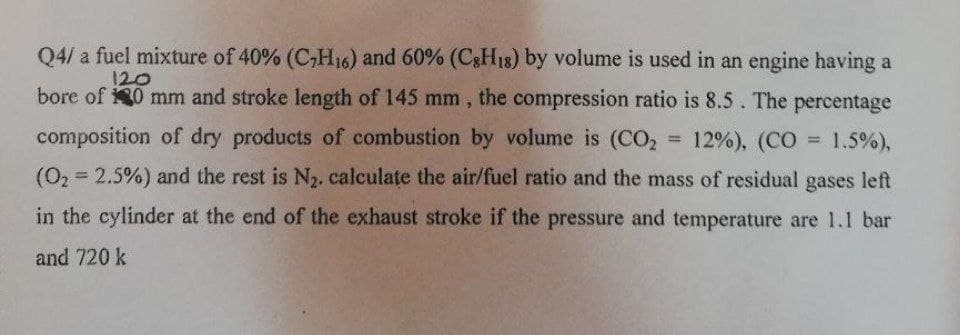Q4/ a fuel mixture of 40% (C,H16) and 60% (CH18) by volume is used in an engine having a 120 bore of 0 mm and stroke length of 145 mm, the compression ratio is 8.5. The percentage composition of dry products of combustion by volume is (CO, = 12%), (CO = 1.5%), %3D (O2 = 2.5%) and the rest is N2. calculate the air/fuel ratio and the mass of residual gases left %3D in the cylinder at the end of the exhaust stroke if the pressure and temperature are 1.1 bar and 720 k
Q4/ a fuel mixture of 40% (C,H16) and 60% (CH18) by volume is used in an engine having a 120 bore of 0 mm and stroke length of 145 mm, the compression ratio is 8.5. The percentage composition of dry products of combustion by volume is (CO, = 12%), (CO = 1.5%), %3D (O2 = 2.5%) and the rest is N2. calculate the air/fuel ratio and the mass of residual gases left %3D in the cylinder at the end of the exhaust stroke if the pressure and temperature are 1.1 bar and 720 k
Principles of Instrumental Analysis
7th Edition
ISBN:9781305577213
Author:Douglas A. Skoog, F. James Holler, Stanley R. Crouch
Publisher:Douglas A. Skoog, F. James Holler, Stanley R. Crouch
Chapter2: Electrical Components And Circuits
Section: Chapter Questions
Problem 2.12QAP
Related questions
Question

Transcribed Image Text:Q4/ a fuel mixture of 40% (C,H16) and 60% (C&H18) by volume is used in an engine having a
120
bore of 0 mm and stroke length of 145 mm , the compression ratio is 8.5. The percentage
composition of dry products of combustion by volume is (CO,
= 12%), (CO
= 1.5%),
%3D
(02 = 2.5%) and the rest is N2. calculate the air/fuel ratio and the mass of residual gases left
in the cylinder at the end of the exhaust stroke if the pressure and temperature are 1.1 bar
and 720 k
Expert Solution
This question has been solved!
Explore an expertly crafted, step-by-step solution for a thorough understanding of key concepts.
Step by step
Solved in 2 steps with 2 images

Knowledge Booster
Learn more about
Need a deep-dive on the concept behind this application? Look no further. Learn more about this topic, chemistry and related others by exploring similar questions and additional content below.Recommended textbooks for you

Principles of Instrumental Analysis
Chemistry
ISBN:
9781305577213
Author:
Douglas A. Skoog, F. James Holler, Stanley R. Crouch
Publisher:
Cengage Learning

Principles of Instrumental Analysis
Chemistry
ISBN:
9781305577213
Author:
Douglas A. Skoog, F. James Holler, Stanley R. Crouch
Publisher:
Cengage Learning